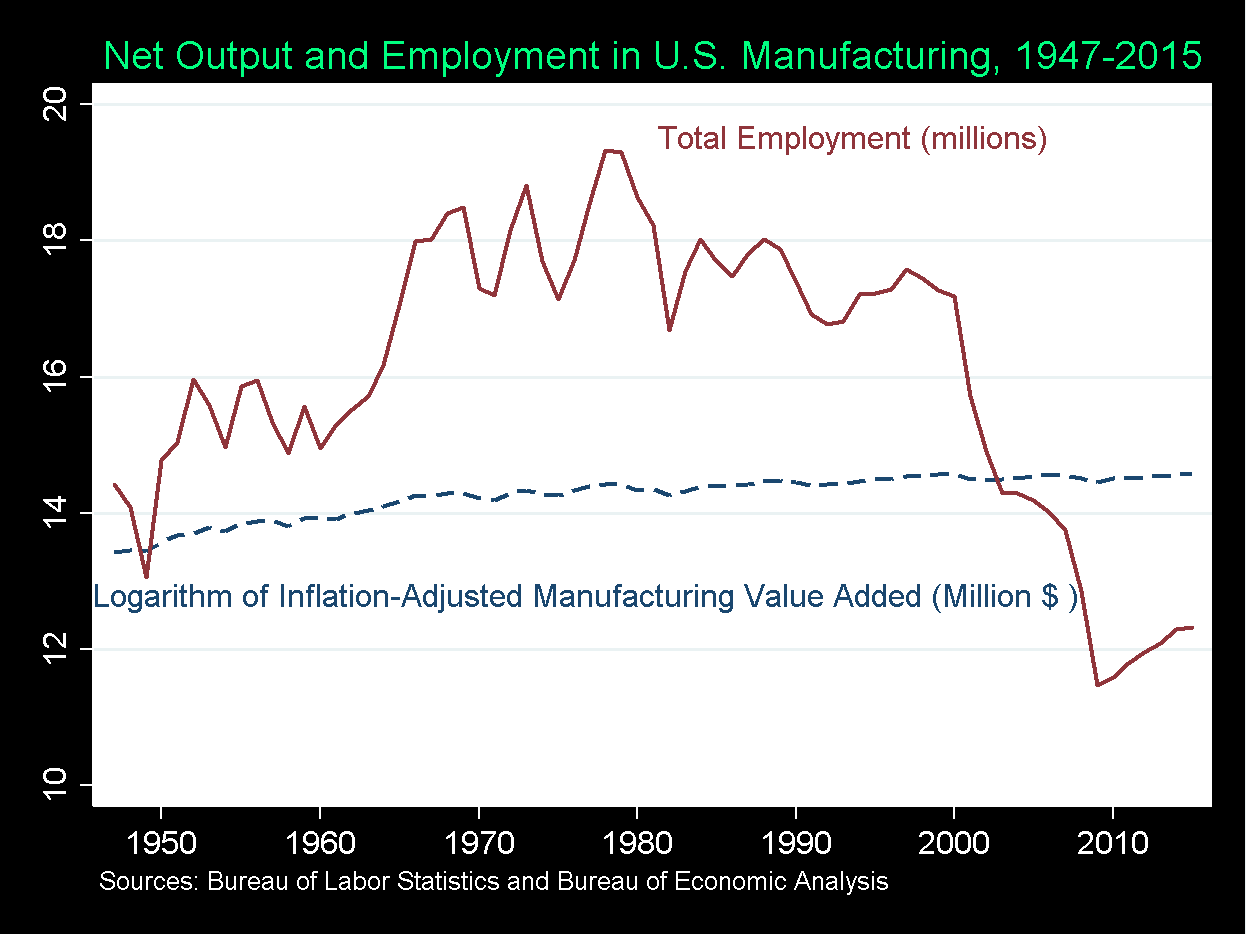Can America Bring Back Manufacturing Jobs? Examining The Challenges And Opportunities

Table of Contents
The Challenges Facing American Manufacturing's Revival
The path to revitalizing American manufacturing jobs is paved with considerable hurdles. Successfully navigating these obstacles requires a multifaceted strategy that addresses both short-term and long-term issues.
Global Competition and Lower Labor Costs
One of the most significant challenges is the intense global competition, particularly from countries in Asia with significantly lower labor costs. This disparity creates a substantial price advantage for overseas manufacturers, making it difficult for American companies to compete solely on the basis of price.
- Cost Advantages Overseas: Manufacturing in countries like China, Vietnam, and Bangladesh offers considerably lower wages, reduced overhead, and often less stringent environmental regulations. These factors can drastically cut production costs.
- Impact on Pricing: American manufacturers often find themselves unable to match the lower prices offered by their international competitors, leading to reduced market share and lost sales.
- Difficulties in Competing on Price: Simply lowering wages in the US to match these lower labor costs isn't a viable or ethical solution, leaving American manufacturers to seek alternative strategies to remain competitive. Data from the Bureau of Labor Statistics consistently shows the wage gap between US and overseas manufacturing workers.
Automation and Technological Advancements
The rise of automation and robotics is transforming the manufacturing landscape, significantly impacting the demand for human labor. While technology offers increased efficiency and productivity, it also leads to job displacement in certain sectors.
- Impact of Automation on Job Displacement: Automation technologies, such as robotic process automation (RPA) and advanced robotics, are replacing human workers in repetitive tasks across various manufacturing processes.
- Reskilling and Upskilling the Workforce: Addressing this challenge requires a significant investment in reskilling and upskilling the workforce to meet the demands of a more automated environment. This necessitates robust training programs focusing on advanced manufacturing technologies.
- Potential for New, Higher-Skilled Jobs: While automation reduces the need for low-skilled labor, it also creates opportunities for higher-skilled jobs in areas such as robotics engineering, data analytics, and software development within the manufacturing sector. Examples include the growing demand for technicians to maintain and program automated systems.
Infrastructure Deficiencies and Supply Chain Issues
The US faces infrastructure deficiencies that hinder the efficiency and cost-effectiveness of domestic manufacturing. Furthermore, the vulnerability of global supply chains, exposed by recent disruptions, poses another considerable challenge.
- Impact of Aging Infrastructure: Outdated transportation networks, limited energy infrastructure, and a lack of reliable broadband access in certain regions increase manufacturing costs and reduce efficiency.
- Challenges of Reshoring Due to Supply Chain Disruptions: The reliance on global supply chains makes American manufacturers susceptible to disruptions caused by geopolitical instability, natural disasters, or pandemics. Reshoring presents logistical hurdles and increased costs.
- Potential Solutions: Investing in modernizing infrastructure, including transportation networks, energy grids, and digital connectivity, is crucial to supporting domestic manufacturing and enhancing its competitiveness. Strengthening domestic supply chains through strategic partnerships and diversification of suppliers is equally important. Examples include investments in high-speed rail and improved port facilities.
Opportunities for Growth and Job Creation in US Manufacturing
Despite the challenges, significant opportunities exist for growth and job creation in the US manufacturing sector. Strategic investments and policy changes can help to unlock this potential.
Reshoring and Nearshoring Initiatives
The trend of reshoring – bringing manufacturing back to the US – and nearshoring – relocating it to nearby countries – is gaining momentum. This offers several advantages.
- Benefits of Reshoring: Improved control over supply chains, reduced transportation costs, increased domestic job creation, and a boost to the national economy are key benefits.
- Government Incentives and Policies Supporting Reshoring: Government incentives, such as tax breaks and grants, are playing a crucial role in encouraging companies to bring manufacturing back to the US.
- Successful Reshoring Cases: Several companies have successfully reshored operations, demonstrating the viability of this approach and its positive impact on job creation. Examples include companies leveraging automation to reduce labor costs while maintaining domestic production.
Investing in Innovation and Advanced Manufacturing
Investing in research and development, advanced technologies, and a skilled workforce is paramount to the success of American manufacturing.
- Potential of Industry 4.0 Technologies: Technologies like artificial intelligence (AI), the Internet of Things (IoT), and big data analytics offer immense potential for improving efficiency, creating new job opportunities, and enhancing competitiveness.
- Government Investment in Education and Training Programs: Government investment in education and training programs that focus on STEM fields and advanced manufacturing skills is essential to creating a skilled workforce capable of utilizing these technologies.
- Successful Examples of Innovative Manufacturing Processes and Technologies: Innovative manufacturing processes such as additive manufacturing (3D printing) and advanced robotics are already transforming various industries and creating new high-skilled jobs.
Focus on Niche Markets and Specialized Production
Concentrating on high-value-added manufacturing and specialized products where the US possesses a competitive advantage can offset the challenges of lower labor costs in other countries.
- How Focusing on Niche Markets Can Offset Lower Labor Costs: By specializing in areas requiring advanced skills and technology, US manufacturers can command premium prices and maintain profitability even with higher labor costs.
- Examples of Specialized Manufacturing Sectors: Aerospace, medical devices, and advanced materials are examples of sectors where the US has a strong competitive advantage.
- Government Support for Niche Industries: Government support for research and development in these specialized areas can further bolster their competitiveness and foster job growth.
Conclusion
Revitalizing American manufacturing jobs presents both significant challenges and substantial opportunities. Global competition, automation, and infrastructure deficiencies pose obstacles, but reshoring initiatives, investment in innovation, and a focus on niche markets offer pathways to success. A multifaceted approach, combining strategic investments in infrastructure, workforce development, and technological advancement, is crucial. The future of American manufacturing jobs hinges on the ability to adapt to a changing global landscape while leveraging the nation’s strengths in innovation and specialized production. Let's work together to revitalize American manufacturing jobs and build a stronger future for our economy. We must ensure continued investment in American manufacturing jobs and the development of manufacturing jobs in the USA to remain competitive in the global market.

Featured Posts
-
 Protomagia Sto Oropedio Evdomos Idanikes Drastiriotites Gia Oloys
May 20, 2025
Protomagia Sto Oropedio Evdomos Idanikes Drastiriotites Gia Oloys
May 20, 2025 -
 Mikhael Shumakher Radost Dedushki
May 20, 2025
Mikhael Shumakher Radost Dedushki
May 20, 2025 -
 Big Bear Ai Holdings Bbai Stock Plummet Understanding The 2025 Decline
May 20, 2025
Big Bear Ai Holdings Bbai Stock Plummet Understanding The 2025 Decline
May 20, 2025 -
 Efimereyontes Iatroi Patras Savvatokyriako 12 And 13 Aprilioy
May 20, 2025
Efimereyontes Iatroi Patras Savvatokyriako 12 And 13 Aprilioy
May 20, 2025 -
 Le Mercato Des Restaurants De Biarritz Nouvelles Adresses Et Chefs Talentueux
May 20, 2025
Le Mercato Des Restaurants De Biarritz Nouvelles Adresses Et Chefs Talentueux
May 20, 2025
Latest Posts
-
 See Vybz Kartel Live In New York Details Of The Historic Show
May 21, 2025
See Vybz Kartel Live In New York Details Of The Historic Show
May 21, 2025 -
 Vybz Kartel Speaks Out Prison Life Freedom Family And New Music
May 21, 2025
Vybz Kartel Speaks Out Prison Life Freedom Family And New Music
May 21, 2025 -
 The Goldbergs A Comprehensive Review Of Every Season
May 21, 2025
The Goldbergs A Comprehensive Review Of Every Season
May 21, 2025 -
 Vybz Kartels New York Concert Details On The Landmark Performance
May 21, 2025
Vybz Kartels New York Concert Details On The Landmark Performance
May 21, 2025 -
 The Goldbergs The Shows Impact On Pop Culture
May 21, 2025
The Goldbergs The Shows Impact On Pop Culture
May 21, 2025
